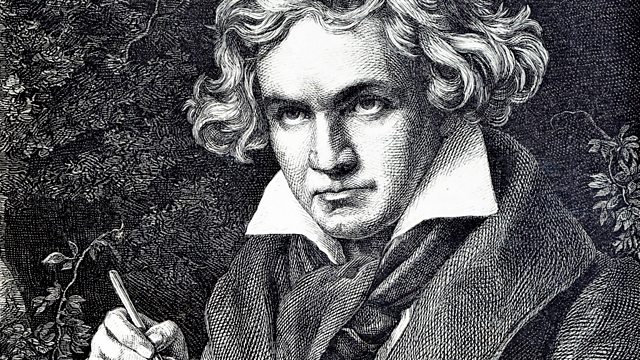
Summer in Heiligenstadt
Donald Macleod explores how Beethoven's acceptance of his deafness spawned masterpieces, including his Symphony No 2, three Op 30 violin sonatas and two Op 31 piano sonatas.
For Beethoven, 1802 marked both an emotional nadir and a peak of creativity. Donald Macleod explores how the composer's acceptance of his deafness spawned a string of masterpieces.
If Bonn had had a child protection unit in the 1770s, its officers would doubtless have been frequent callers at 24 Rheingasse, the Beethoven family home. A neighbour might have heard little Ludwig calling out from the cellar where he had been locked up by his drunkard father Johann, or witnessed one of the regular beatings Johann administered to 'encourage' his son to practice the piano. Yet from this abusive background, Ludwig van Beethoven emerged as the greatest musician of his age - the composer who absorbed the Classical legacy of Haydn and Mozart, then utterly transformed it. This week, Donald Macleod charts the course of this transformation in a series of five snapshots of Beethoven's life and work, from his first attempts at composition to the extraordinary productions of his final years.
Today's programme focuses on six months in 1802, when Beethoven, on doctor's orders, took a rest-cure in the tiny, picturesque spa-town of Heiligenstadt. For some years the composer's hearing had been deteriorating but, by 1801, things had started to reach crisis point. In June of that year Beethoven wrote a despairing letter to his childhood friend Franz Wegeler, now a distinguished medic. Wegeler recommended a change of doctor, and it was the new man - Johann Adam Schmidt - who advised Beethoven to abscond to Heiligenstadt to give his hearing a rest away from the noisy bustle of Vienna. Here Beethoven wrote the document known by posterity as the Heiligenstadt Testament - a letter to his brothers, to be read only after his death, in which he expressed despair at his hearing loss but determination nonetheless to fulfil what he felt to be his artistic destiny. His productivity during the summer of 1802 bears witness to that determination; here he wrote or completed his 2nd Symphony, the three violin sonatas Op 30, two of the piano sonatas Op 31, and more besides.
Last on
Music Played
-
![]()
Ludwig van Beethoven
7 Bagatelles Op.33 For Piano - no.7 in A flat major; Presto
Performer: Stephen Kovacevich.- PHILIPS : 426-976-2.
- PHILIPS.
- 7.
-
![]()
Ludwig van Beethoven
Sonata No. 16 In G Major Op.31`1 For Piano
Performer: Daniel Barenboim.- EMI: 572912 2.
- EMI.
- 1.
-
![]()
Ludwig van Beethoven
Sonata No. 9 In E Major Op.14`1 For Piano - 3rd movement; Rondo
Ensemble: Leipzig Gewandhaus String Quartet.- MEMBRANE RECORDS : NCA-60139.
- MEMBRANE RECORDS.
- 12.
-
![]()
Ludwig van Beethoven
Symphony No. 2 In D Major Op.36- 1st movement; Adagio molto - allegro con brio
Conductor: Emmanuel Krivine. Orchestra: La Chambre Philharmonique.- NAIVE : V-5258.
- NAIVE.
- 5.
-
![]()
Ludwig van Beethoven
Sonata In C Minor Op.30`2 For Violin And Piano
Performer: Gidon Kremer. Performer: Martha Argerich.- DG RECORDS : 445-652-2.
- DG RECORDS.
- 4.
Broadcasts
- Christmas Eve 2013 12:00����ý Radio 3
- Tue 21 Apr 2015 12:00����ý Radio 3
- Tue 21 Apr 2015 18:30����ý Radio 3
Beethoven Unleashed – the box set
What was really wrong with Beethoven?
Composers A to Z
Who knew? Five eye-opening stories from Composer of the Week
Five reasons why we love Parry's Jerusalem
What is the strange power of Jerusalem which makes strong men weep?
A man out of time – why Parry's music and ideas were at odds with his image...
The composer of Jerusalem was very far from the conservative figure his image suggests.
Composer Help Page
Find resources and contacts for composers from within the classical music industry.





